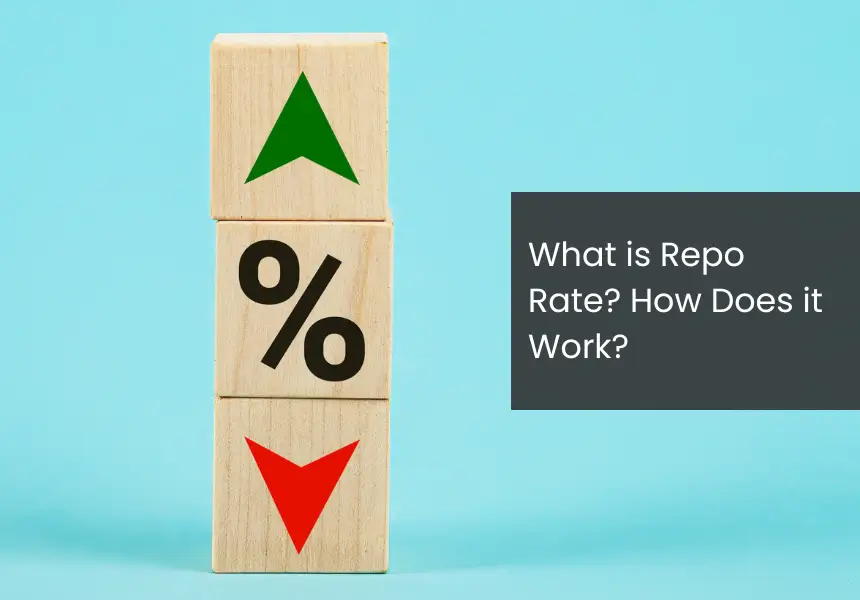
Did you know there are strategies for finding competitive loan rates? By understanding the repo rate, you can grab better and more competitive loan deals.
The Repo Rate or Repurchase Agreement Rate is the interest rate at which the Reserve Bank of India (RBI) lends short-term funds to commercial banks in India. In simple terms, it is the rate which banks pay to borrow money from the RBI.
At times, when a bank goes low on cash, it borrows money from the RBI. However, the RBI charges an interest when it lends money to commercial banks. This, in turn, affects your interest rates on loans and savings accounts. So, the lower the repo rate, the cheaper it is for banks to borrow, potentially leading to lower loan rates for you!
Let’s look at how the repo rate works in detail.
How Does Repo Rate Work?
The repo rate is used by a country’s central bank, like the Reserve Bank of India (RBI), to influence the flow of money in the economy. Here’s how it works:
Lending by the Central Bank:
- Commercial banks borrow short-term funds from the central bank when they face a shortage of liquidity.
- The repo rate is the interest rate that the central bank charges commercial banks for these loans.
Impact on Money Supply and Interest Rates:
The central bank uses the repo rate to control the money supply in the economy.
- Increasing the repo rate: This makes borrowing from the central bank more expensive for commercial banks. As a result, banks tend to lend less money themselves, reducing the overall circulation of money in the economy. This is used to combat inflation by making borrowing more expensive and reducing spending.
- Decreasing the repo rate: This makes borrowing cheaper, encouraging banks to lend more. This increases the money supply in the economy and can stimulate economic activity during slowdowns.
Impact on Borrowers and Depositors:
Changes in the repo rate influence the interest rates offered by commercial banks. When the repo rate rises, banks generally raise their lending rates (interest rates on loans like car loans or home loans), which discourages borrowing and investment. Conversely, a decrease in repo rate leads to lower lending rates, making borrowing more affordable.
Why is Repo Rate important?
The repo rate is important for several reasons:
Controls Inflation:
The repo rate is used to maintain financial stability in the economy by keeping inflation in control. By adjusting the repo rate, central banks can influence the amount of money circulating in the economy. An increased repo rate makes borrowing more expensive, which can reduce spending and investment, thereby helping to control inflation. Conversely, reducing the repo rate makes borrowing cheaper, which can increase spending and investment.
Manages Economic Growth:
The central bank responds to economic fluctuations by adjusting the repo rate. During periods of economic slowdown, a lower repo rate can help in the growth by encouraging borrowing and investment. Similarly, when the economy is booming, a higher repo rate can prevent the economy from overheating and keep inflation in check.
Impacts Interest Rates:
The repo rate is a benchmark for other interest rates in the economy. Commercial banks generally adjust their lending and deposit rates when the repo rate changes. This affects the cost of borrowing for things like homes, cars, and businesses and the returns on savings accounts and fixed deposits.
How Does RBI Calculate Repo Rate?
The RBI doesn’t calculate the repo rate directly using a formula. Instead, the RBI’s Monetary Policy Committee (MPC) decides on it based on India’s current economic situation.
When deciding the repo rate, the MPC considers factors like inflation, growth rate, and credit availability. By adjusting the Repo Rate, the RBI aims to achieve its monetary policy goals, which involve balancing inflation and maintaining economic growth.
What is the Current Repo Rate In India?
The current repo rate in India has been fixed at 6.50%. This means it’s the interest rate at which the Reserve Bank of India (RBI) lends short-term funds to commercial banks.
How Does Repo Rate Impact Personal Loan EMI?
Changes in the repo rate, set by the RBI, can impact the interest rates on your loan. This effect is more direct for loans with floating interest rates, which change based on market conditions.
When the repo rate goes up, borrowing becomes more expensive for banks and NBFCs. They raise interest rates on loans, including personal loans, to maintain profits. This leads to higher interest payments for borrowers. Conversely, a lower repo rate allows banks to borrow at a cheaper rate. They may then pass on this benefit by lowering personal loan interest rates. This results in a reduction in your EMI.
However, changes in the repo rate don’t immediately affect your EMI. Banks and NBFCs might take some time to adjust their interest rates. It is important to stay updated on the changes in repo rates and how they might affect your personal loan EMI.
Regardless of repo rate fluctuations, maintaining a good credit score and payment history can help you secure personal loans at more favorable interest rates.
Conclusion
The repo rate is important for the central bank to manage the country’s economic health. By adjusting the repo rate, the RBI can influence factors like inflation, borrowing costs, and overall economic activity. Understanding how the repo rate works is essential to making informed financial decisions. You must stay updated on changes in the repo rate to help anticipate fluctuations in personal loan interest rates.
Frequently Asked Questions
Who sets the Repo Rate?
A country’s central bank, such as the Reserve Bank of India (RBI), sets the repo rate.
What is the difference between Repo Rate and Reverse Repo Rate?
The repo rate is the rate at which central banks lend money to commercial banks, while the reverse repo rate is the rate at which commercial banks can park their excess funds with the central bank.
How often is the Repo Rate reviewed?
The central bank reviews the repo rate periodically, often during monetary policy meetings at least four times a year.
How does a change in Repo Rate affect the common man?
Changes in the repo rate can affect loan interest rates, which in turn impact EMIs for home loans, car loans, and other borrowings. A higher repo rate can lead to higher EMIs, while a lower repo rate can reduce EMIs.
What are the factors that influence changes in the Repo Rate?
The central bank considers various factors when changing the repo rate, including current inflation rates, economic growth data, global economic conditions, and financial market stability.








